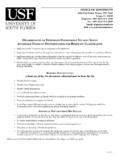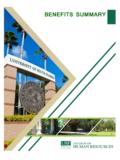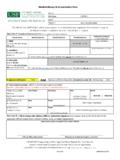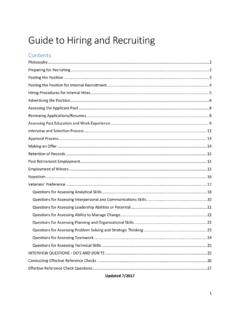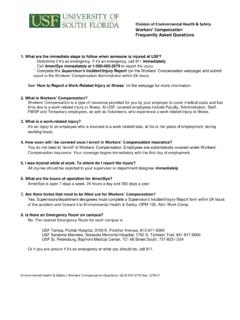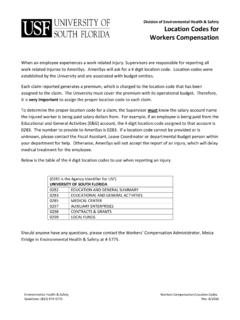Transcription of A Stakeholder Analysis of the BP Oil Spill and the ...
1 UNIVERISTY OF SOUTH FLORIDA. A Stakeholder Analysis of the BP Oil Spill and the Compensation Mechanisms Used to Minimize Damage An Honors Thesis Katelyn Brennan 11/29/2013. Abstract The BP oil Spill released million barrels of oil into the Gulf of Mexico and caused a grave amount of damage to the surrounding areas both environmentally and economically. The states most impacted were Louisiana, Mississippi, Alabama, Texas, and Florida. The main stakeholders in relation to the Spill were the environment, wildlife, fisherman, the oil industry, and tourist-driven businesses and communities. Directly following the Spill , BP set up The Gulf Coast Claims Facility (GCCF) which was later deemed not independent and later replaced by a court supervised settlement program which took the subjectivity of the eligibility out of the equation. Three years after the oil Spill , BP announces that the compensation fund was running low but they would continue to pay the settlements from their profits.
2 Yet BP attempts to stem the flow of incoming claims using several methods, including suing the court appointed administrator and appealing claims. In January 2013, BP pleads guilty to 11 counts of felony manslaughter, one count of felony obstruction of Congress, and violations of the Clear Water and Migratory Bird Treaty Acts. BP was sentenced to pay $4 billion in fines and penalties. The Deepwater Horizon Oil Spill has shown that the regulation for Spill prevention and response are not sufficient. As the oil companies will act in the best interest of themselves, it is the duty of the government to set regulation in place in the interest of the health and safety of its citizens. The government needs to act to create tighter controls on oil companies to decrease the likelihood of a repeat occurrence. 1. Table of Content Overview of the BP Oil Spill .. 3. Stakeholder Theory .. 5. Environmental 6. Economic 7. Compensation Mechanisms .. 9. BP Compensation 9. Economic and Property Damages Settlement.
3 12. Corporate Responsibility .. 21. BP's Responsibility .. 22. Criminal Charges .. 23. BP's Response .. 28. Action Needed .. 33. Works Cited .. 38. Table of Figures Figure 1: Oil Spills by Size .. 4. Figure 2: Stakeholders of the BP Oil Spill .. 5. Figure 3: Medical Geographic 11. Figure 4: Economic Loss Zones .. 12. Figure 5: Summary of Damage 13. Figure 6: Eligible Geographic E&PD Settlement Zones .. 15. Figure 7: Fixed and Variable Costs for Claim Purposes .. 17. Figure 8: Risk Transfer Premium Rates .. 18. Figure 9: Administrative and Accounting Fee Reimbursement .. 19. Figure 10: BP Stock Prices .. 22. Figure 11: A Brief Summary of the BP Oil Spill Effects .. 26. Figure 12: Criminal Charges: Fines and Penalties .. 27. Figure 13: Income Statement .. 35. 2. Overview of the BP Oil Spill On April 20, 2010, the Deepwater Horizon oil rig exploded. While the fire on the platform was still being contained Transocean and BP were assessing their options. Transocean is the company that owned and staffed the Deepwater Horizon rig.
4 BP is the company who leased and provided the supervisors aboard the rig, in addition to being 65%. owner of the Macondo oil well. The Macondo well had been damaged in the explosion and was leaking oil into the Gulf of Mexico. The well contained over 110 million barrels of oil and was greater than 13,000 feet below sea level (Cleveland, 2010). The well discharged oil into the Gulf of Mexico for eighty-seven days until the attempt to cement the well shut was successful, but at that point the damage was already done. An estimated million barrels of oil was released into the Gulf, contaminating the waters and surrounding shorelines (Federal On-Scene Coordinators, 2011). After the Spill , a federal joint task force was assigned to determine the cause of the oil Spill . They concluded that BP, Transocean and Halliburton, the contractor used to seal the damaged well, shared responsibility for the explosion and consequent damages, but that BP was "ultimately responsible".
5 BP has a history of misconduct. They have had 63 reported incidents of misconduct since 1995 (Sheppard, 2013). These prior health and safety violations resulted in an explosion in a Texas refinery in 2005 and a fire in an Ohio refinery in 2006. These instances killed 30 people and injured over 200 others. For three years, from 2007 to 2010, BP's healthy and safety violations made up 97% of the "egregious, willful" violations issued by the Occupational Safety and Health Administration (OSHA) (Thomas, Cloherty, & Ryan, 2010). 3. In April 2011, BP and Halliburton sued each other claiming that the other was responsible for the disaster, including the explosion and resulting leak. A federal judge ruled that Halliburton was not liable, leaving BP responsible for all claims. Similarly, in January 2012, it was ruled that Transocean was only liable for fines under the Clean Water Act and its share of punitive damages, not economic loss claims. As displayed by Figure 1, The BP oil Spill is not the largest Spill by volume but it has had one of the worse impacts due to its location in the Gulf of Mexico near a number of major metropolitan areas.
6 The stakeholders of the oil Spill are widespread, varying from individuals and businesses to the environment and entire industries. BP Chief Executive, Tony Hayward, stated shortly after the Spill that "we are taking full responsibility for the Spill and we will clean it up and where people can present legitimate claims for damages we will honor them" (Cleveland, 2010). Figure 1: Oil Spills by Size (Potenza, 2010). 4. Stakeholder Theory Stakeholder theory simply states that the stakeholders of a company are not just its direct owners but that stakeholders are any person, group or entity that a corporation has benefited or burdened by its actions and those who benefit or burden the firm with their actions (Steiner, 2012; Miles, 2012). The first stakeholders impacted by the Deepwater Horizon Oil Spill were the workmen on the rig itself. When the rig exploded 126 people were on the platform, only 115 were evacuated (Cleveland, 2010). After a three day search covering 5,200 miles, the Coast Guard called off the rescue operation stating that the period for reasonable expectations of survival had passed.
7 Sadly, the 11 presumed dead members of the crew would not be the only ones impacted by this tragedy. Other major stakeholders include, the environment, the Gulf fishing industry, and tourist-dependent businesses and communities. Figure 2: Stakeholders of the BP Oil Spill (Brennan, 2013). Tourists Oil Spill Clean- Tourist-driven Up Workers businesses Environmental Tourist-driven Activists communities Stakeholders in the BP Oil Spill Government Fisherman Media Environment Oil Industry 5. Environmental Impact The environment is always a Stakeholder in oil spills. The environmental impact of an oil Spill on sea organisms and their ecosystems has been well-documented. The Oil Pollution Act of 1990 mandates that a Natural Resources Damage Assessment be compiled for each oil Spill . The assessment allows restoration efforts to be completed in the areas of most need by measuring the impact in terms of fish killed and wetland destroyed. The report compiled for the BP oil Spill states that approximately 1,100 miles of coastal wetland were victim to the effects of the Spill (National Academy of Sciences, 2013).
8 It was determined that areas where vegetation and root systems were eradicated by the Spill , erosion will convert marshland into open water. The Fish and Wildlife Service determined that 32 National Wildlife Refuges are at risk as a result of the oil Spill , including Breton National Wildlife Refuge, the second oldest refuge in the country (Cleveland, 2010). Oil can cause harm through physical contact, inhalation, and absorption. Ingestion of oil by marine animals has shown organ damage, ulceration, lowered immune systems, skin irritation, and changes in behavior. For three years, from 2010 through 2012, 817. bottlenose dolphin deaths were reported compared to a steady average of 100 deaths per year that was documented during the previous seven years, between 2002 and 2009. (National Academy of Sciences). BP used a variety of known methods to minimize the amount of oil that would reach shore, including burning, skimming, and chemical dispersants. These methods were very effective in decreasing the volume of the oil by as much as 40%, but the long term effects of these techniques to the oceanic ecosystems remains unknown (National Academy of 6.)
9 Sciences). It is apparent that the effects of this Spill will continue to be seen for years to come. Economic Impact The economic impact is still not fully known. Many different stakeholders were economically affected as a result of the Spill , both directly and indirectly. Fisherman in the area, as well as hotels, restaurants, and other businesses tied to tourism, felt the most immediate effect. The commercial production of fish decreased by 20% due to fishery closures (National Academy of Sciences). In 2008, commercial fisherman in the Gulf harvested over 1 billion pounds of fish and shellfish (Cleveland, 2010). Now the safety of seafood harvested from the Gulf is in question leaving the livelihood of Gulf fisherman in a precarious situation. With the heavy media coverage, including images of the ruined coastline and the frequency of tar balls appearing on shore, positive public perception and tourism in the Gulf of Mexico has declined. One year after the Spill , rental reservations were still down by over 25% (Jones, 2011).
10 Companies, especially those involving excursions into the water, such as scuba diving and sailing, are under constant question as to whether there is still oil in the water. Eilene Beard, a local business owner in Pensacola, FL, stated that people who call usually ask multiple times if she is sure that the water is safe. She believes that what is keeping tourists away is the constant uncertainty of the quality of the water (Jones, 2011). Areas such as Fort Meyers, where tourism shouldn't have been impacted by the oil Spill , as surface oil never appeared on their shores, also experienced a significant decrease in the amount of tourism due to negative public perception of tainted waters and shores. Although the area was not directly affected, BP paid $500,000 to Lee County in order assist 7. with the cost of advertising. Lee County spent over $1,250,000 in advertising to attempt to counteract the negative public opinion of the area without satisfactory success (Finn, 2013).
